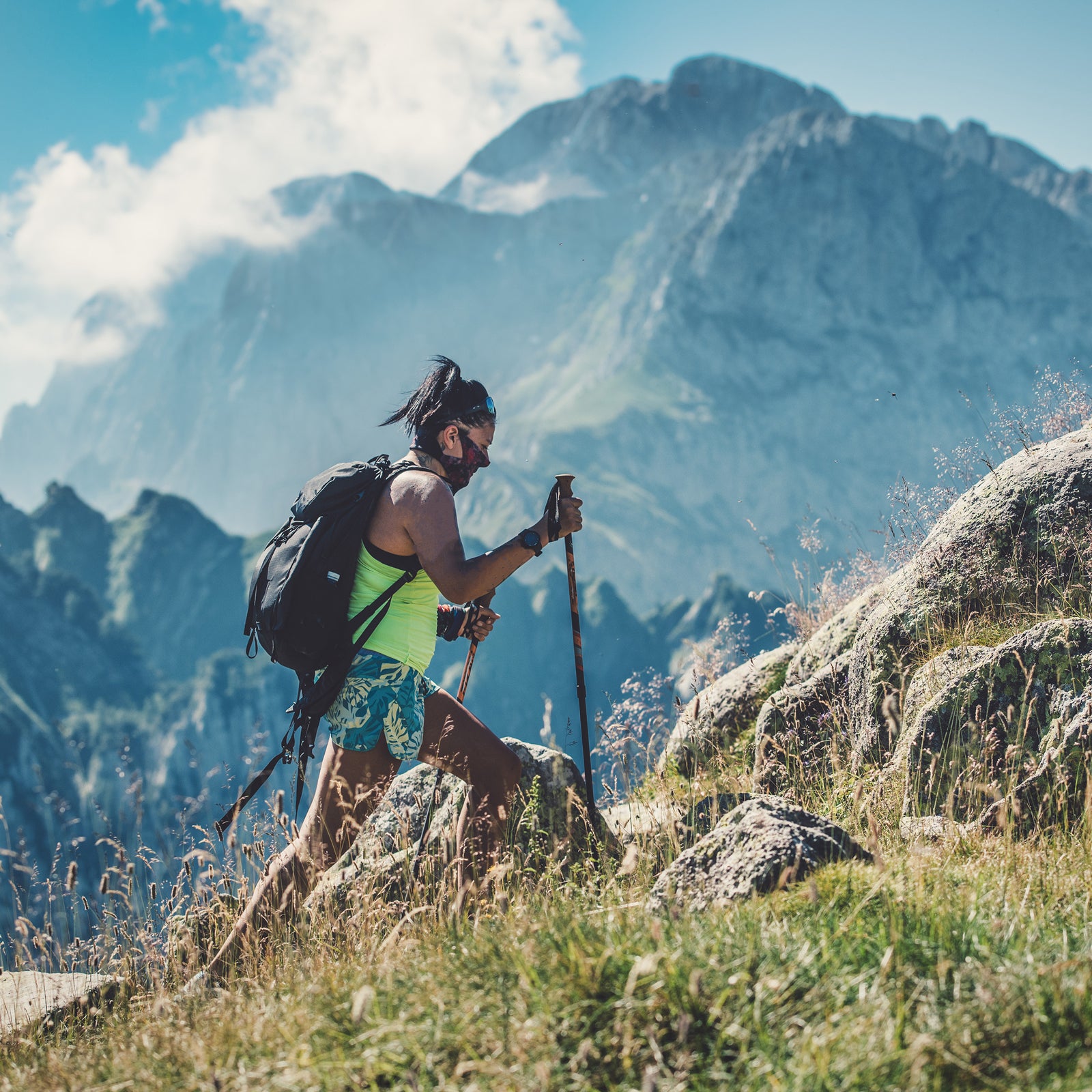Our understanding of the coronavirus pandemicÔÇöand wearing masksÔÇöhas changed rapidly over the past seven╠řmonths. Early on, public health authorities in the U.S. ╠řon the contradictory grounds that they╠řwerenÔÇÖt helpful and that mask supplies should be reserved for frontline health care workers. , however, several states were mandating mask use in public places,╠ř╠řeven in the outdoors. (Research ╠řwhile the outdoors is safer than indoor spaces, there are still higher risks for those who go without face coverings than those who wear them.)
In the past couple of months, weÔÇÖve╠řseen the rise of specialty masks made of performance materials that are better suited for exercise. This is potentially great news for anyone whoÔÇÖs tried to knock out a quick morning run or ride in a stifling-hot N95. One of the prime qualities of sports masks is that theyÔÇÖre more breathable. But better breathability often comes at the expense of filtration efficiency, which╠řbegs the question: Do╠řthese masks work?
Answering this also requires a look into another contentious debate about face coverings, which is whether neck gaiters and bandanasÔÇöpopular choices among athletesÔÇöare effective.╠řMost recently, found that respiratory emissions actually seemed to increase when the test subject was wearing a gaiter. That sparked a huge controversy about whether gaiters were actually ÔÇťworse than no mask at all,ÔÇŁ╠řas ╠řin its headline. The kerfuffle largely subsided when experts in the field .
But that still leaves the question of whether sports masks can both breathe well and perform their intended function. What, exactly, makes a mask work well or not? We talked to some experts to find out╠řand tested as many as we could find to pick our favorites.╠ř
- How Masks Work╠ř
- Do Masks Made from Performance Fabrics Work?╠ř
- Do╠řGaiters and Neck Tubes Work?╠ř
- Do I Even Need to╠řWear a Mask ║┌┴¤│ď╣¤═°?╠ř
- What to Look for in a Mask
- Our Favorite Face Coverings for Sports
How Masks Work
A and collection of informational╠ř and ╠řhave driven╠řhome the fact that humans are a veritable fount of respiratory emissions. (This will likely cause us to think differently about crowded environments like stadiums and spin-class studios for years to come.) Every time we speak, cough, or just exhale, we emit a range of liquid particlesÔÇödroplets as large as half a millimeter in diameter and tiny aerosols at the submicron level (a micron, also known as micrometer, is 1/1,000th of a millimeter).╠ř
Masks work by catching these particles between our airway and the outside environment via . ÔÇťParticles can kind of bang into a fiber and stick there,ÔÇŁ says Loretta Fernandez, a professor of civil and environmental engineering at Northeastern University who is for filtration efficiency. ThatÔÇÖs called impaction. The other primary filtering method, called diffusion, is where ÔÇťthe really small particles slow down and enter this diffusive zone where they╠řfuse to the fiber,ÔÇŁ she says.
You might note that measures of filtration commonly focus on how well a mask intercepts particles 0.03 microns in diameter. ThatÔÇÖs not because the coronavirus is solely or even most frequently found in particles that size (itÔÇÖs found in particles of all sizes), but because itÔÇÖs one of the harder ones to catch. Fernandez explains that small particles get removed by diffusion and╠řlarger ones by impaction. The size range that both methods most often miss is 0.03 microns. ThatÔÇÖs why 0.03 microns makes a pretty decent proxy for mask performance. ÔÇťIf a mask has a high efficiency at submicron points, itÔÇÖll be even more effective in the droplet-size range,ÔÇŁ says Yang Wang, a professor of civil and environmental engineering at Missouri University of Science and Technology whoÔÇÖs .
Do Masks Made from Performance Fabrics Work?
Wang and Fernandez arenÔÇÖt the only scientists researching filtration and cloth masks, but their findings help us understand what makes a mask work well or not. The good news for athletes is that performance fabrics can filter as well as cotton, which is often seen as a preferred material because it can be densely woven. Some fibersÔÇöwool in particularÔÇöcarry an electrostatic charge that may increase filtering efficiency by attracting particles with an opposite charge, particularly if theyÔÇÖre blended with other fibers (the rubbing ). And wool is not the only option. As anyone whoÔÇÖs ever pulled apart a dryer load of workout clothes knows, polyester-based performance fabrics have . Still, the fiber a fabric is made from seems to matter less than a fabricÔÇÖs weave or knit density, the number of layers, and the shape and size of the mask itself.╠ř
WangÔÇÖs test results note a relationship between fabric weight and performance. Heavy fabrics, which Wang used as a proxy for densely woven fabrics, typically did better. His lab also systematically tested materials layered╠řone, two, three, and four times. Not surprisingly, filtration efficiency improves as you add layers, but even small differences in fabric density can have a significant effect on performance. Cotton can filter between 20 and 58 percent of 0.03 micron particles, depending on whether╠řitÔÇÖs four layers of a cheap bandana that weighs 28 grams per square meter or four layers of a 600-thread-count pillowcase thatÔÇÖs about 25 percent heavier, at 35 grams per square meter. Just two layers of a polyester microfiber cleaning cloth that was twice as heavy as the four-layer cotton pillowcase caught almost 70 percent of 0.03 micron particlesÔÇöbetter filtration for roughly the same weight╠řin half the layers. (By comparison, a standard N95 mask, made of a dense mat of , not woven, polypropylene fabric is so named because the certification requires the mask to catch at least 95 percent of these tiny particles.)
WangÔÇÖs work assessed only the material itself, not a maskÔÇÖs fit. But fit also plays a crucial role. Testing by Fernandez and her coauthor, Amy Mueller, offers . Namely: what matters is how well a mask seals around the wearerÔÇÖs face.
Fernandez and Mueller tested masks by measuring air inside and outside the mask over three one-minute intervals as a tester (Fernandez) wore the mask. Then they added a section of nylon hosiery on the outside╠řand measured one more time. The hosiery pressed the mask tightly against the wearerÔÇÖs face to seal it properly,╠řbut itÔÇÖs sheer enough that it didnÔÇÖt affect filtration. Masks that already fit well saw no or little change in performance, while looser-fitting masks didÔÇömost by 10╠řto 15 percent, and some as high as 40 percent. Why? Looser masks leak particles around the edges, especially on either side of╠řthe nose. A key factor was╠řwhether a mask had a nose wire. ÔÇťThe masks we tested that did not have nose wires were at the bottom of our list for effectiveness,ÔÇŁ says Fernandez. ÔÇťEspecially if the mask is thick, you have these gaps around the nose. A nose wire is critical for a good fit.ÔÇŁ
Mask size also seems to matter. WangÔÇÖs fabric testing simulated three different sizes of mask and found that, as surface area increased, so did filtering efficiency. (Wang thinks this is because it reduces air pressure.)╠řThis also helps improve╠řanother performance metric that matters to athletes: pressure drop, the differential between the air inside the mask and the air outside. A low pressure drop means a mask breathes well╠řbut usually correlates with low filtering efficiency. If you increase mask size, says Wang, you can lower pressure drop without a big negative impact on filtration.
In a nutshell, masks made from╠řsynthetic fabrics are fine, as long as they fit securely and are not too sheer╠ř(a large surface area helps, too). Wang also╠řmeasured filtering performance on all the fabrics in his test after one, five, and ten╠řwash cycles. He found no degradation of ability across multiple different materials.╠ř
So, Sports Masks Work. Do╠řGaiters and Neck Tubes?
If youÔÇÖre looking at pure surface area, the biggest face covering you can find is a neck gaiter. By that logic, gaiters should work well as face coverings. How, then, do you reconcile WangÔÇÖs takeaway with the results of the Duke study?╠ř
The Duke study wasnÔÇÖt a test of masks; rather, said coauthor Martin Fischer, the idea was to propose a low-cost testing setup. The Duke researchersÔÇÖ hypothesis for why the gaiter seemed worse than no mask at all was that the fabric was splitting larger droplets into smaller aerosols. But no one in the Duke group is an aerosol expert, and thatÔÇÖs not generally how aerosol filtration works.╠řRyan Davis, a Trinity University aerosol expert, looked at this specific scenario and estimated that at the╠řair velocities the researchers tested. Linsey Marr, a highly regarded aerosol expert at Virginia Tech ╠řthat she suspected that the researchers might actually have been capturing fabric shedding (polyester fabrics are notorious for this, particularly when new). Marr followed up by and reported that they seemed to filter as well as other designs, especially when thin gaiters were╠řfolded double.╠ř
One possible reason for the confusion/debate is that because gaiters are the largest masks you can find, they have the lowest pressure drop, thereby reducing╠řair velocity. Of course, particles emitted during respiration may pass through thin material, but a╠řlow pressure drop may aid╠řdiffusion, with particles floating around inside the gaiter until they get stuck on fabric╠řor your skin. The upshot? Neck tubes are probably fine, but as Wang and MarrÔÇÖs work both show, itÔÇÖs best to double up the layers.╠řOn the other hand, WangÔÇÖs╠řtest results╠řsuggest that cotton bandanas are likely the least effective option,╠řbecause the fabric is simply not dense enough to block most respiratory emissions.
Do I Even Need to Wear a Mask ║┌┴¤│ď╣¤═°?
Early on, public-health authorities focused most on direct transmission via larger droplets╠řand contact transmission via surfaces contaminated by those droplets. ThatÔÇÖs where recommendations like six-foot distancing came╠řfrom. But in early July, a group of over 200 researchers, including Marr,╠ř the World Health Organization to acknowledge╠řwhat their work increasingly made clear: COVID-19╠řis also transmitted via small airborne particles╠řcalled aerosols.
ÔÇťThese very small particles might go deeper into your lungs,ÔÇŁ says Karen Kormuth, a biologist at Bethany College who specializes in aerobiology and RNA viruses (like the flu and coronavirus). ÔÇťThat potentially causes a more serious infection.ÔÇŁ╠řDeep inhalation is more likely to occur╠řwith heavy, open-mouth breathingÔÇölike during exercise. WhatÔÇÖs more, that, in the lungs, these deeply lodged virions in a hyperactive immune response, popularly called a cytokine storm, which╠řcan actually make cases worse.
On the other hand, open air is an important factor limiting infection risk outdoors, and UV light from full sun╠ř in just a few minutes.╠řBesides, encounters with others on the road or trail are often transient. If you briefly pass a person shedding coronavirus in their breath, is that enough to get you sick? Probably not. A new preprint study (one not yet peer-reviewed) from experts at Colorado State University proposes a metric called Effective Rebreathed╠řVolume (ERBV)╠řthat . In every scenario modeled, outdoor ERBV was far less than it was indoors, except at distances of less than 1.6 feet.╠ř
Still, even outside, long╠řinteractions raise risk. Erin Bromage, an immunologist and a biology professor specializing in infectious diseases at the University of Massachusetts, wrote in a in May that the formula for successful infection is exposure multiplied by╠řtime. The risk is low, if not zero, for those passing interactions on the trail. But each interaction, and specifically each additional block of time you spend in someone elseÔÇÖs company, increases your potential exposure.╠řThat means going on group runs, rides, and hikes╠řwithout a mask still carries danger.
There have only been of outdoor transmission. But Shelly Miller, an engineering professor at the University of Colorado and a prominent expert on╠řCOVID-19╠řaerosol spread, that she still always uses a face covering on mountain-bike rides.
No one measureÔÇönot masks, not distance, not handwashingÔÇöis an impermeable barrier to transmission. WhatÔÇÖs key is combining╠řthem to reduce exposure to the smallest possible level. ÔÇťEspecially if youÔÇÖre exercising around other people, you should wear a mask and keep distance,ÔÇŁ says Kormuth.
Anecdotally speaking, wearing a mask can send╠řa strong pro-social signal. It tells others, ÔÇťHi, IÔÇÖm a responsible person, and IÔÇÖm doing all I can to protect us both.ÔÇŁ (The reverse .)
Athletes object that masks are uncomfortable, inhibit their ability to do hard workouts, or cause their oxygen saturation to drop. ThatÔÇÖs mostly correct╠ř(you shouldnÔÇÖt experience a significant drop in oxygen saturation, but be smart; if you feel symptoms like extreme shortness of breath or dizziness, reduce your workout intensity). But none of that means wearing a mask while exercising is hard. A pandemic that has taken in less than eight months is hard.╠řTwice as as the worst recession in the last 50-plus years is hard. Kids losing crucial in-person educational and development opportunitiesÔÇöwhile dodging ÔÇöis hard. Wearing a mask on rides, runs, and hikes to help limit the diseaseÔÇÖs spread is, at most, a minor inconvenience.╠ř
Even imperfect masks are better than none at all. Fernandez points out that masks work cumulatively (albeit on a logarithmic scale): if two people who are interacting are each wearing a mask that catches 50 percent of exhaled particles,╠řbetween them╠řtheyÔÇÖll catch 75 percent. No, itÔÇÖs not N95 levels of protection. But itÔÇÖs still significant. Want to learn more about aerosols and COVID-19? are fantastic open-source information sites╠řthat were helpful for this story.
The Test
I spent the past few months evaluating 12 sports masks from 11 different companies: Athleta (Made to Move), Asics, Buff, Eliel, Headsweats, La Sportiva, Outdoor Research, RunMitts, Under Armour, Verge Sport, and Zensah. The test was simple. I used them during my regular road, gravel, and mountain-bike rides and assessed them for fit, comfort, size, and breathability. (While we could╠řnarrow down the field of masks based on a few criteria, testing how well they each intercept respiratory emissions was beyond my capabilities without a lab.)
General Findings: What to╠řLook for in a Sports Mask
A larger mask should filter better (if it fits properly).
I also found they fit more comfortably for open-mouth breathing during hard exercise, seemed to have lower pressure drop (i.e., breathe better), and usually fogged sunglasses the least.
Get a mask with multiple layers of fabric.╠ř
Every piece of test data we have says that multiple layers filter better than single layers. Generally, the denser the fabric weave or knit, the better. Thickness can be a proxy for density, as WangÔÇÖs results with the microfiber shop cleaning cloth╠řshowed. Masks should block most light when held up to a bright window. If you can see through a mask, it might catch droplets╠řbut will be less effective against aerosols.
Look for a mask that sits close to your face.
I liked masks that sat close to my face best. Some exercise masks, like the Asics Runner Mask and Under Armour╠řSports Mask, are designed to sit off the face to avoid some of the claustrophobic feeling people can experience. The extra space felt nice to begin with, but within about 10 to 15 minutes, sweat and exhaled breath began to condense on my skin, creating an unpleasant greenhouse sensation. Close-fitting masks in performance fabrics seemed to work like wicking base layers, keeping both my face and the mask drier.
Ear loops are better than behind-the-head ties, depending on the use.
For cyclists, ear-loop attachments play much better with helmets than behind-the-head loops do. TheyÔÇÖre also quicker to reposition if you pull the mask down when others arenÔÇÖt around. For trail runners, the security of a behind-the-head attachment may help keep the mask in place better.╠ř
Nose wires matter.
A nose wire is the feature most manufacturers need to incorporate but donÔÇÖt. They help immensely with mask fit, which means better filtration efficiency. For anyone wearing sunglasses, they also reduce fogging. Almost all the masks in my test fogged glasses when I was working hard at low speeds on steep climbs; some caused fog╠řeven at 15 miles per hour. But masks with nose wires fogged the least. My testing took place in warm temperatures (60 to 80 degrees). I imagine that when it gets colder the problem will worsen.
The Best Face Coverings for Sports
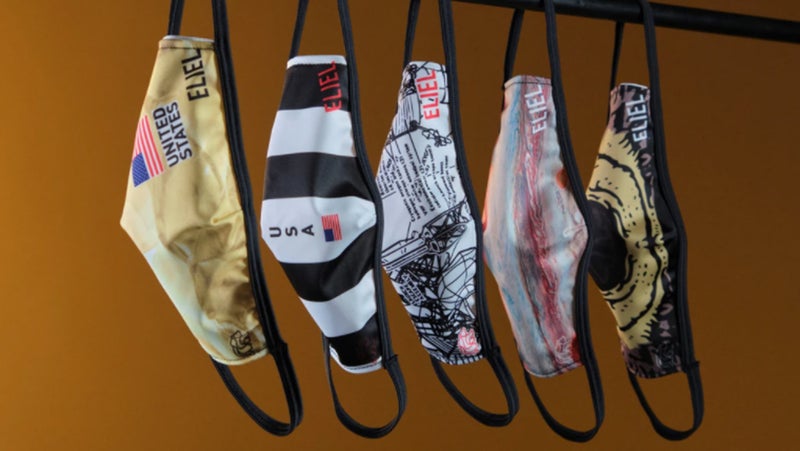
Best Overall:╠řEliel Fun Facades Face Mask╠ř($50 for Five)
Eliel gets most of the basics right with , which comes╠řin large and small sizes (you can buy a five-pack of one size or a mixed six-pack with three of each). TheyÔÇÖre generously sized, yet fit snugly all around the face. That large surface area combined with a medium-thick, double-layer quilted polyester knit fabric provides a low pressure drop (breathability!) with full coverage. ItÔÇÖs soft,╠řfeels nice against the skin, and╠řwicks very well. While it lacks a nose wire, a sunglasses nosepiece helps it conform to the face reasonably wellÔÇösomething I didnÔÇÖt find with other masks without nose wires. It has a filter pocket, though Eliel doesnÔÇÖt make or sell filters to fit, and the opening is too small to wrestle in a stock one. Fix that issue, and add a nose wire and some adjustable cinches to the ear loops, and itÔÇÖd be even better.
Best for Large Faces: Outdoor Research Essential Face Mask ($20)
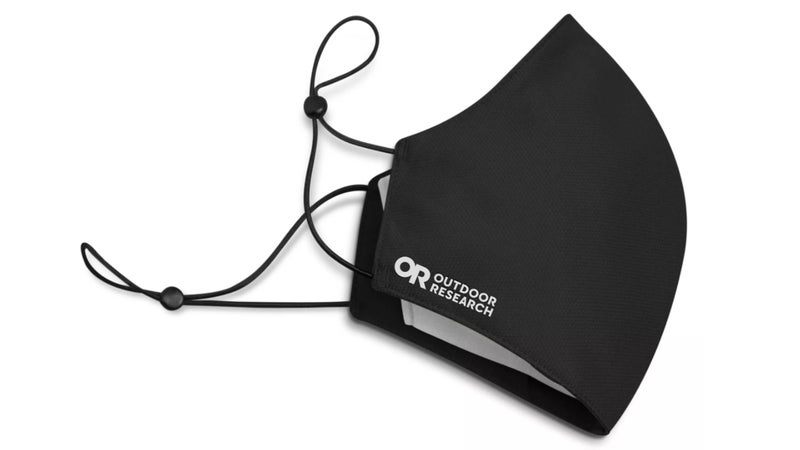
A close second to the Eliel, only comes in one size, but with╠řadjustable cinches on the ear loops,╠řit should work for most folks (though athletes with very small heads may not find these fit as well). What I liked best about this mask was its generous surface area and highly wicking fabric, both great for open-mouth╠řmoderate- and high-intensity exercise. A sturdy nose wire easily conforms to fit your face, stays in place, and helps anchor sunglasses without much fogging. The medium-thick, double-layer quilted polyester knit has an antimicrobial treatment that may help limit contact transmission when you touch the mask. It╠řcomes with a removable filter, but the pocket it fits into needs work. The design features a small flap on each side to hold the filter, which sits╠řnext to your face and is prone to bunching, especially when you╠řpull the mask╠řdown for a drink. IÔÇÖd prefer a true pocket in between the two layers of fabric, with an open top to change filters.
Best for Dynamic Sports: Buff Filter Mask ($29)
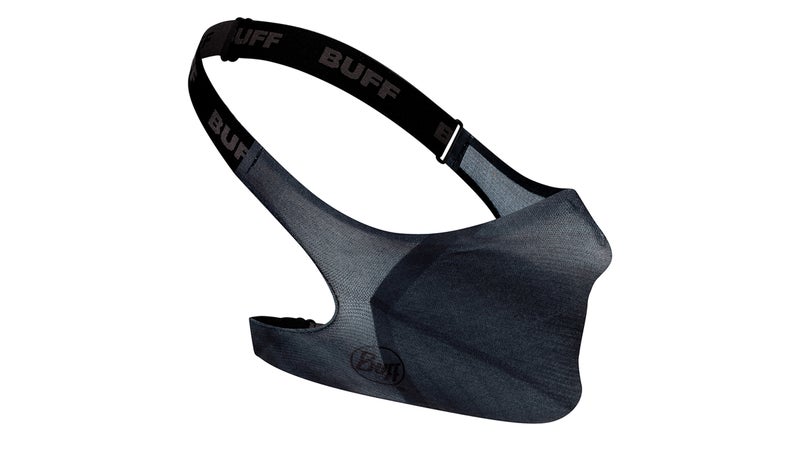
From its wide, comfortable head straps to its╠řhighly breathable, thin double-layer polyester knit fabric, feels made for runners, skiers, and anyone else who does high-motion sports. It has a built-in filter pocket, with five included filters that Buff claims block 98 percent of particles. But the filters easily bunched up every time I moved the mask to get a drink. I also experienced some fogging when wearing sunglasses╠ř(a nose wire would be a welcome addition on future designs). Those issues aside, I found it comfortable and secure. It uses two layers of BuffÔÇÖs Coolnet UV+ fabric, which is treated with the same antimicrobial coating that Outdoor Research uses in the Essential mask, above. This means itÔÇÖs broadly equivalent to a doubled-over Coolnet UV+ gaiter but with a snugger fit.
What IÔÇÖll Probably End Up Using the Most: Buff Original Gaiter ($20)
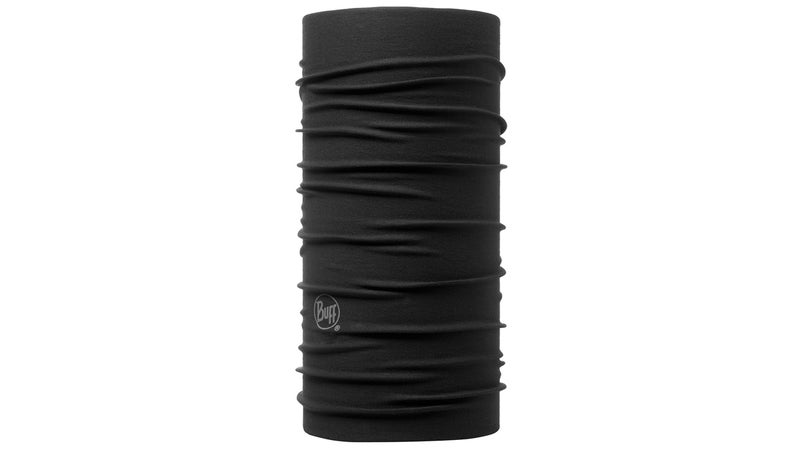
I suspect there are two reasons athletes originally have gravitated to . First,╠řmost of us already own one or more. Second,╠řtheyÔÇÖre the easiest and most comfortable option for intermittent use. Most of my rides are in very sparsely populated areas. Once IÔÇÖm out of town, I might see a handful of people in an hour, so I donÔÇÖt need to wear a mask constantly. A gaiter rests╠řunobtrusively around the neck and is easier and faster to pull up than fishing a mask out of my pocket when I encounter others. The downsides: they donÔÇÖt stay in place nearly as well as a proper mask, and╠řsince theyÔÇÖre made of a thin, single-layer polyester knit, theyÔÇÖre likely only effective if you wear them doubled upÔÇöalthough thatÔÇÖs relatively easy to accomplish. For winter, IÔÇÖve got a soft two-layer merino-wool number╠ř. And like Europeans with their dashing scarves, IÔÇÖm beginning to like the look.╠ř


